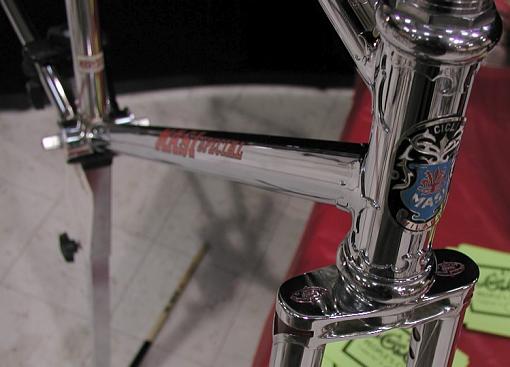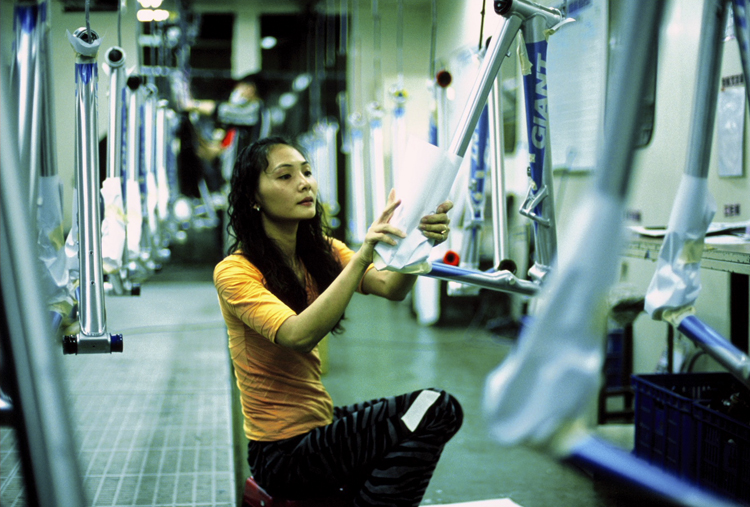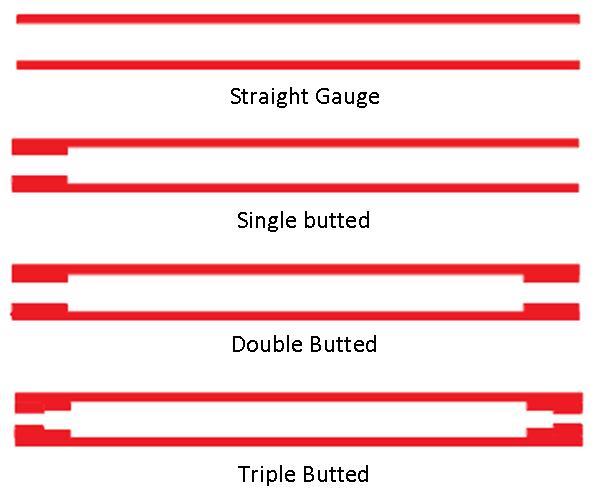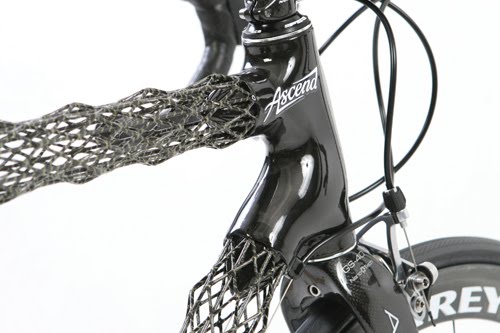Looking for a new road or mountain bike and discovered a whole range of different frame materials? I've put together a brief run down on some of the characteristics and benefits of each material to help simplify your decision.
 "Steel is real" as the old saying goes, or is it a new saying coined when alternative frame materials became more and more popular? Steel was the material of choice for a long time in the bike industry until aluminium came along in the 1970 and 80's.
"Steel is real" as the old saying goes, or is it a new saying coined when alternative frame materials became more and more popular? Steel was the material of choice for a long time in the bike industry until aluminium came along in the 1970 and 80's.
Steel is durable, totally resistant to fatigue stress (when used for standard bike riding anyway) and easily repaired. Its malleability allows dents to be hammered out and a broken frame can easily be welded together again.
These qualities, along with its enormous strength and elasticity, make steel a popular choice for cargo loaded touring and trekking bikes.
The elasticity also produces some flex under load which some say results in a "springy" feeling while riding. I owned and rode a steel frame for many years and while I loved it, I also found it hard to honestly quantify the difference in the ride compared to a good alloy bike...maybe it's just me.
While steel is often viewed as the heaviest frame material, high-end chromoly can be as light as aluminium, but stronger and arguably more compliant or comfortable to ride.
Like all frame materials, not all steel is created equal:
- Hi-Ten steel is found in cheap adult and children's bikes and is relatively weak; as a result frame manufacturers use a lot of it to make the bike strong enough. This means lots of extra weight. Pick up a small kids bike at a supermarket and you will understand!
- 4130 Chromoly is the material of choice for the majority of better quality steel frames on the market today. It is actually an alloy of iron and chromium (and other stuff) and is corrosion resistant, durable and only slightly heavier than aluminium.
- Reynolds make a range of chromoly tubing that is probably the best out there at the moment. I owned and rode a Reynolds frame (Rocky Mountain Blizzard) for many years and loved it. Their 'air hardened' Reynolds 853, (as on the Blizzard), and the supreme Reynolds 953 are as light as the best aluminium, strong as steel, corrosion resistant and have the wonderful ride characteristics inherent in chromoly frames. The downside is they can be very expensive.
- Titanium also has many of the qualities of steel, but is lighter and more expensive again. It is perhaps more durable, but also much more difficult to work with if repairs are needed (unlikely!).
Why Would I Buy?
Apart from cheap supermarket bikes (which I recommend you steer well clear of), steel, or more precisely chromoly, is most often used on touring and boutique or custom built bikes. This is the same for titanium.
So if you are after a touring bike to load up with panniers, many brands offer a steel bike for this exact purpose. Alternatively, if you want something custom or a bit different, with specific ride qualities that you can hand down to your grandchildren, perhaps titanium and chromoly is for you.
ALLOY
 Aluminium is the current material of choice for a large part of the bicycle market because it is relatively inexpensive and performs excellently as a frame material.
Aluminium is the current material of choice for a large part of the bicycle market because it is relatively inexpensive and performs excellently as a frame material.
Aluminium is lighter than steel (when comparing an equally sized tube), but also weaker and is susceptible to fatigue stress and failure over time. Manufacturers use wide diameter tubes with thin walls to achieve the strength and stiffness required for a bicycle frame. Actually, it is interesting to compare the tubing diameter of a steel and aluminium bike.
The wide diameter tubes make aluminium bikes very stiff but may also result in a harsher ride compared with steel or carbon fiber. The stiffness factor is a benefit for sprinting and perhaps climbing, but the harshness of the material may become an issue on longer rides over rough or potholed roads.
Aluminium is more brittle than steel and is harder to repair. Where steel will bend, aluminium will snap. As a result, most modern bikes will use an aluminium derailleur hanger, designed to break to protect the frame. On a steel frame the hanger is just part of the frame itself and can be bent back into position if necessary.
Aluminium is resistant to corrosion and if treated properly will last for years and years.
The alloys used in the bike industry are AA 6061 and AA 7005.
- 6061 aluminium is predominately an alloy of aluminium and magnesium and is the most popular form of alloy used in bicycle frames.
- 7005 is an alloy of mainly aluminium and zinc. Untreated 7005 can be found in cheaper mass market alloy bikes while the heat treated version, which results in a very strong and light alloy, is used in higher end models.
Why Would I Buy?
Alloy bikes are everywhere and are very affordable. If you want to give road riding or racing a go, most bikes up to $2,500 will be alloy and will perform brilliantly. Mountain bikes are alloy to a slightly higher price point, but this is changing all the time.
Aluminium bikes have made high level technology and performance available to everybody, so if you're on a tighter budget don't worry, alloy bikes will do everything that is required and more.
Butting

To increase strength without adding extra weight, frame builders use internal tube 'butting' on chromoly and aluminium tubes. The more butting or intentional variation in tube wall thickness the higher the cost: a result of greater complexity in the manufacturing process.
- Straight gauge tubing is the same thickness for the length of the tube.
- Single butted tubes are thicker at one end, like the seat tube which is thicker at the bottom bracket junction.
- Double butted is thinner in the middle than either end where the tube is joined or welded.
- Triple butted takes the next step with three variations in tube wall thickness.
CARBON FIBER
 Carbon fiber is the new kid on the block. The structure is a composite of strands of carbon pressed together with an epoxy glue or resin. This makes it possible to mould into virtually any shape desirable as can be seen by the new wave of aerodynamic road bikes now entering the market.
Carbon fiber is the new kid on the block. The structure is a composite of strands of carbon pressed together with an epoxy glue or resin. This makes it possible to mould into virtually any shape desirable as can be seen by the new wave of aerodynamic road bikes now entering the market.
For a more detailed picture of carbon fiber see this article: "What to look for when buying a $2500-$3000 road bike"
Carbon is by far the lightest frame material and can be made very stiff. The 'grainy' nature of the fibers allows frame builders to adjust stiffness and compliance by aligning the carbon layers in varying ways.
For example: stiffness in the bottom bracket and head tube areas for power delivery and control, and compliance in the seat tube and stays for rider comfort.
To visualise this, see the Cervelo R3 and Cannondale SuperSix. Both these bikes feature fat down tubes and bottom bracket areas, but check the seat stay; almost impossibly thin, particularly on the Cervelo.
Carbon fiber will not corrode, but it does require greater care than bikes made from metal and may not be as durable long term. A deep scratch or hard knock can damage the integrity of the structure creating the danger of a major failure.
A good quality carbon frame is also the most expensive option.
Why Would I Buy?
Because carbon fiber bikes are the pinnacle of design, performance and weight. All high-end performance bikes are carbon (apart from the odd boutique titanium and steel as mentioned). All professional racers, road and mountain, use carbon bikes.
If you have the money and want performance, this is the bike.
It should be pointed out that not all carbon is the same. Cheaper carbon bikes can be heavy and have very poor riding characteristics, check with your LBS before purchasing. If it looks too good to be true, chances are it is. Often a good quality alloy frame out performs a cheap carbon one.


